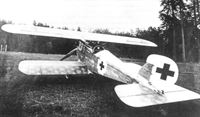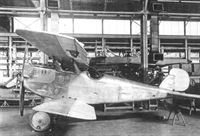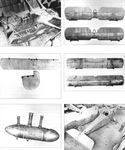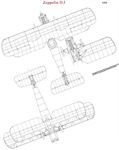
Описание
Страна: Германия
Год: 1918
Fighter
O.Thetford, P.Gray German Aircraft of the First World War (Putnam)
Zeppelin-Lindau (Dornier) D I
This single-seat fighter was another of Claude Dornier's research essays, this time into the realm of cantilever-wing construction. About two-thirds of the wings were aluminium sheet-covered, over alloy ribs and spars, forming a torsion-box structure. The remainder of the wings, from the rear spar to trailing edge, were fabric-covered, as were also the unbalanced ailerons. The fuselage was an all-metal, stressed-skin assembly, incorporating the vertical fin, all other tail surfaces being fabric-covered. Other unique features were the - apparent - single-leg undercarriage and the streamlined jettisonable fuel tank slung underneath the fuselage.
Although not listed in the official list of types participating in the second D types Competition at Adlershof in the summer of 1918, the Zeppelin D I was among several other types submitted for evaluation by Front Line pilots, as an adjunct to the D Competition. The machine was then fitted with Mercedes D III engine, and when being flown by Oblt. Reinhard in July 1918 it shed a top wing with fatal results. Another aircraft, with B.M.W. engine installed, competed in the third D types Competition (which was for B.M.W.-powered aircraft only). Performance was disappointing, and in speed the Zeppelin fighter was surpassed by seven other types. Bongartz' succinct report said: "Does not possess characteristics of a modern fighter. Ailerons too heavy."
Engine: 185 h.p. B.M.W. IIIa. Span, 7.8 m. (25 ft. 7 1/8 in.). Length, 6.37 m. (20 ft. 11 in.). Area, 18.7 sq.m. (202 sq.ft.). Weights: Empty, 710 kg. (1,562 lb.). Loaded, 890 kg. (1,958 lb.). Armament, twin Spandau machine-guns.
N.B. Two Zeppelin D Is were taken to the U.S.A. after the war and evaluated by the Army and Navy respectively.
Описание:
- O.Thetford, P.Gray German Aircraft of the First World War (Putnam)
- W.Green, G.Swanborough The Complete Book of Fighters
- M.Schmeelke Zeppelin-Lindau Aircraft of WW1 (A Centennial Perspective on Great War Airplanes 42)
- M.Dusing German Aviation Industry in WWI. Volume 2 (A Centennial Perspective on Great War Airplanes 85)
Фотографии
-
M.Schmeelke - Zeppelin-Lindau Aircraft of WW1 /Centennial Perspective/ (42)
Zeppelin D.I 1751/18
-
M.Schmeelke - Zeppelin-Lindau Aircraft of WW1 /Centennial Perspective/ (42)
Zeppelin D.I 1751/18 Ersatz
-
M.Schmeelke - Zeppelin-Lindau Aircraft of WW1 /Centennial Perspective/ (42)
Zeppelin D.I 1752
/18 -
M.Schmeelke - Zeppelin-Lindau Aircraft of WW1 /Centennial Perspective/ (42)
Zeppelin D.I evaluated at Wright Field postwar
-
M.Schmeelke - Zeppelin-Lindau Aircraft of WW1 /Centennial Perspective/ (42)
Despite carrying the Zeppelin-Lindau name, the division headed by Claudius Dornier the D.I, first flown on 4 June 1918, was designed by Adolph Rohrbach, head of the Zeppelin-Staaken division. Like its few Zeppelin-Lindau forebears, this latest single seat, biplane fighter used light alloy as its primary structural material. Externally, the 185hp BMW IIIa powered D.I was an exceptionally clean design, with fully cantilevered wings and tail unit, bereft of any external and, hence, drag-producing bracing struts or wires. Rushed through the design and assembly phases in order to compete in the second 1918 Adlershof fighter competitions, the disassembled D.I was dispatched by train immediately after its maiden flight. Reportedly, while still in transit, someone re-checking at the factory discovered that the upper wing attachment fittings were too weak and alerted Adlershof not to fly the aircraft until strengthened fittings could be rushed to them. Sadly, whether the information was not received, or simply ignored, the D.I was flown twice after re-assembly, Hermann Goring being the first service pilot to fly it, followed by Hptm Wilhelm Reinhardt, who lost his life after the upper wing detached in mid-air. At least two other D.Is were built, as two found their way to the US soon after the war, to be tested by the US Army and Navy, respectively. Earlier German testing had been critical of the aircraft's lack of speed, said to be 124mph at sea level, and general heaviness of the controls.
-
M.Dusing - German Aviation Industry in WWI. Volume 2 /Centennial Perspective/ (85)
Zeppelin D.I with BMW IIIa engine (1918)
-
M.Schmeelke - Zeppelin-Lindau Aircraft of WW1 /Centennial Perspective/ (42)
The D.I (D.1752/18) at the beginning of June 1918 with the 185 HP BMW IIIa engine. A larger radiator from the Suddeutscher Kuhlerfabrik had to be mounted for the more powerful BMW engine.
-
M.Schmeelke - Zeppelin-Lindau Aircraft of WW1 /Centennial Perspective/ (42)
The D.I 1751/18 on the field in Zech prior to its transport to Adlershof. (Airbus Group)
-
J.Herris - Weird Wings of WWI /Centennial Perspective/ (70)
The all-metal Zeppelin D.I 1752/18, the first protoype to fly, is seen here. Zeppelin D.I 1751/18, the second prototype to fly, was entered in the Second Fighter Competition where, during an evaluation flight on July 3, 1918, the upper wing tore off. Hptm. Wilhelm Reinhard, who had succeeded Manfred von Richthofen as the commander of JGI, was killed in the subsequent crash. Oblt. Hermann Goring had flown the fighter immediately prior to Reinhard.
-
M.Schmeelke - Zeppelin-Lindau Aircraft of WW1 /Centennial Perspective/ (42)
D.I (D.1752/18) prior to its maiden flight on June 4th, 1918.
-
M.Schmeelke - Zeppelin-Lindau Aircraft of WW1 /Centennial Perspective/ (42)
Preparing to start on the Zech field ahead of the D.I's (D.1752/18) maiden flight on June 4th, 1918. Pilot Sergeant Ruppert prepares for the flight in front of the left wing.
-
M.Schmeelke - Zeppelin-Lindau Aircraft of WW1 /Centennial Perspective/ (42)
Zeppelin D.I 1751/18 Ersatz (replacement). The Zeppelin D.I had the most advanced airframe technology of any WWI aircraft. The metal monocoque construction it pioneered was used for decades thereafter.
-
M.Dusing - German Aviation Industry in WWI. Volume 2 /Centennial Perspective/ (85)
Zeppelin D.I with BMW IIIa engine (1918)
A 1918 Zeppelin D.I All-metal Wireless Scout. One 185 h.p. BMW IIIa engine. -
M.Dusing - German Aviation Industry in WWI. Volume 1 /Centennial Perspective/ (84)
Zeppelin D.I 1751/18 Ersatz (replacement).
The all-metal Zeppelin D.I, with its fully semi-monocoque construction, had the most sophisticated structure of any WWI aircraft. Designed by Claude Dornier, its structural technology is still being used. -
M.Schmeelke - Zeppelin-Lindau Aircraft of WW1 /Centennial Perspective/ (42)
The ZWL D.I 1751/18 with a 160 HP D IIIa engine in flight. (Airbus Group)
-
M.Schmeelke - Zeppelin-Lindau Aircraft of WW1 /Centennial Perspective/ (42)
Zeppelin D.I in Germany before being shipped to the USA.
-
M.Schmeelke - Zeppelin-Lindau Aircraft of WW1 /Centennial Perspective/ (42)
Zeppelin D.I in the USA postwar. This one was bought by the US Navy for research.
-
M.Schmeelke - Zeppelin-Lindau Aircraft of WW1 /Centennial Perspective/ (42)
Zeppelin D.I in the USA postwar. The wings were metal covered in their front half and fabric covered aft.
-
M.Schmeelke - Zeppelin-Lindau Aircraft of WW1 /Centennial Perspective/ (42)
Zeppelin D.I in the USA in the Naval Aircraft Factory, Philadelphia. Curtiss MF-Boat hulls are stored in the background. The wings were metal covered in their front half and fabric covered aft.
Другие самолёты на фотографии: Curtiss MF - США - 1918
-
M.Schmeelke - Zeppelin-Lindau Aircraft of WW1 /Centennial Perspective/ (42)
A Zeppelin D.I with 185 hp BMW.IIIa being tested by the U.S. Army at McCook Field in 1922. The all-metal Zeppelin D.I fighter had the most advanced structure of any WWI aircraft. Prototypes were powered by both the Mercedes D.IIIa and by the 185 hp BMW.IIIa. The surface of the wings aft of the box spar had fabric covering, as did the horizontal tail surfaces. This example was brought to the USA for testing after the war and is shown after re-assembly. Other than its biplane configuration, this was the preview of future propeller-driven fighters until the jet age; then early jets used similar structural technology. Postwar the Zeppelin D.I was often referred to as the 'Dornier D.I' in honor of its brilliant designer, Dipl-Ing. Claude Dornier, who later founded his own company, but Zeppelin D.I, the company name during the war (or Zeppelin-Lindau D.I after the division of the company), is what it was called when it was designed, built, and flown, and therefore is the correct designation. The fuel tank under the fuselage could be jettisoned in case of fire.
-
M.Schmeelke - Zeppelin-Lindau Aircraft of WW1 /Centennial Perspective/ (42)
Zeppelin D.I in the USA postwar. It bears the Air Service serial No. 68546 and the McCook Field Number P-241.
-
M.Schmeelke - Zeppelin-Lindau Aircraft of WW1 /Centennial Perspective/ (42)
Zeppelin D.I in the USA postwar. It was designated A.S.68546. The radiator is large to keep the engine cool.
-
M.Schmeelke - Zeppelin-Lindau Aircraft of WW1 /Centennial Perspective/ (42)
Vice Sargeant (Vizefeldwebel) Ruppert, a test pilot, here in the Zeppelin D.I., was instrumental to the success of the metal land aircraft. Photo dated Sep. 8,1918. (Reinhard Zankl)
-
M.Schmeelke - Zeppelin-Lindau Aircraft of WW1 /Centennial Perspective/ (42)
The fuselage construction of the D.I in monocoque construction. (Airbus Group)
-
M.Schmeelke - Zeppelin-Lindau Aircraft of WW1 /Centennial Perspective/ (42)
Monocoque construction was used for the wings for the first time.
-
R.Kosin - The German Fighter since 1915 /Putnam/
Zeppelin (Dornier) D I upper wing structure.
-
M.Schmeelke - Zeppelin-Lindau Aircraft of WW1 /Centennial Perspective/ (42)
The tail assembly of the D.I in the hangar in Reutin. (Airbus Group)
-
M.Schmeelke - Zeppelin-Lindau Aircraft of WW1 /Centennial Perspective/ (42)
Zeppelin D.I in USA
These photos show stages in the destructive structural testing of the two Zeppelin D.I prototypes in the USA postwar. -
M.Schmeelke - Zeppelin-Lindau Aircraft of WW1 /Centennial Perspective/ (42)
Zeppelin D.I in USA
The components of the two D.I fighters were marked D.I and D.II so that they could be assembled correctly on arrival in the USA. -
M.Schmeelke - Zeppelin-Lindau Aircraft of WW1 /Centennial Perspective/ (42)
Zeppelin D.I in USA
-
M.Schmeelke - Zeppelin-Lindau Aircraft of WW1 /Centennial Perspective/ (42)
Zeppelin D.I in USA
-
M.Schmeelke - Zeppelin-Lindau Aircraft of WW1 /Centennial Perspective/ (42)
Zeppelin D.I in USA
-
M.Schmeelke - Zeppelin-Lindau Aircraft of WW1 /Centennial Perspective/ (42)
Zeppelin D.I in USA
-
M.Schmeelke - Zeppelin-Lindau Aircraft of WW1 /Centennial Perspective/ (42)
The fuel gauge of the ZWL D.I's droppable 100 liter tank, that was attached to the underside of the fuselage.
-
M.Schmeelke - Zeppelin-Lindau Aircraft of WW1 /Centennial Perspective/ (42)
Broken landing gear of the D.I (1752/18) on June 4th, 1918 in Zech. After the accident upon landing, the duraluminum connecting tube was replaced with one made of reinforced steel. Despite some more hard landings in following flight tests, there were no more complaints. (Airbus Group)
-
W.Green, G.Swanborough - The Complete Book of Fighters
Two of the four examples of the D I were taken to the USA for evaluation.
-
R.Kosin - The German Fighter since 1915 /Putnam/
Dornier Do D.I








































